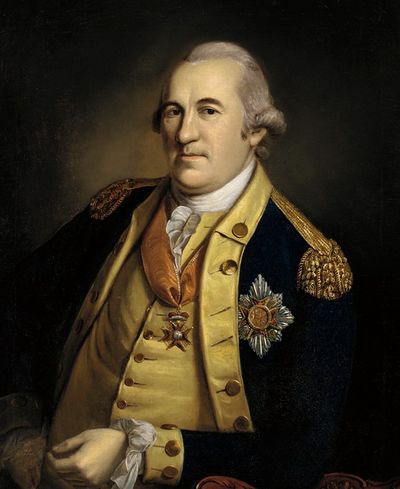Annotation:Baron Stubens March
X:1 % T:Baron Stubens March M:C L:1/8 R:March S: Seth Johnson – Woburn Fife Manuscript (c. 1807-40?, p. 17) Z:AK/Fiddler’s Companion K:C (3GAB|c2 c>c c2 (3cde|e2 d>d d2 (3gec|B2c2 .d.c.B.A|GFED C2 (3GAB| c2 e>e e2 (3gec|B2 d>d d2 (3fdB|c3e dcBA|G2 G>G G2:| |:GABc|d2 d>d d2 dgfe|f/g/f/e/ d/e/d/c/ B2 G/A/B/c/|d2 d>d dfed| c/d/c/B/ A/B/A/G/ F2 c/d/e/f/|g2 g>g g>ff>e|fdBGE3G|f3f feed| ecGE C2 (3GAB|c>cG>G e>ec>c|f>fd>d g>ge>e|dagf e2 (3fed|c2 c>c c2:|]
BARON STUBENS MARCH. American, March (whole time). C Major. Standard tuning (fiddle). AABB. The march was printed in Samuel Holyoke's Instrumental Assistant, vol. 1 (Exeter, N.H., 1800), and appears in a few American musicians' manuscripts of the last decade of the 18th century and first decade of the 19th. It can be found in fifer John Treat's copybook (1779-c. 1800, a 1790 music manuscript from Massachusetts (some entries made by John Bartlett), flute player John Hoff's manuscript (Lancaster, Pa, 1797), and the Woburn Fife Manuscript (1807-c. 1840, inscribed by Seth Johnson).

The title honors Friedrich Wilhelm August Heinrich Ferdinand Steuben (born Friedrich Wilhelm Ludolf Gerhard Augustin von Steuben (1730-1794), also referred to as Baron von Steuben [1], a Prussian and later an American military officer. He served as inspector general and a major general of the Continental Army during the American Revolutionary War and is credited with being one of the fathers of the Continental Army in teaching them the essentials of military drills, tactics, and disciplines.
